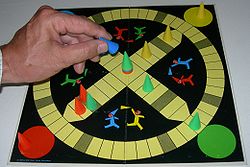Catch the hat
| Catch the hat shell game |
|
|---|---|

|
|
| Game data | |
| author | CA Nitsche-Neves |
| graphic | Fritz Ehlotzky |
| publishing company | Ravensburger |
| Publishing year | 1927 |
| Art | Dice board game |
| Teammates | 2 to 6 |
| Duration | 30-45 minutes |
| Age | from age 6 |
Fang den Hut (in Switzerland also: Hütchenspiel , in English: Coppit or Trap the Cap ) is a board game and Pachisi descendant for two to six, ideally four players. The Otto Maier Verlag, Ravensburg published invented by the German emigrants C.A. Nitsche-Neves game in 1927 in the Elo series. Fritz Ehlotzky was the graphic designer of the game board, which has hardly changed to this day .
procedure
Catch the Hat is a simple dice and run game that includes elements of pachisi . The fact that it was able to establish itself worldwide, although it was only invented in the 20th century, is also due to the fact that for the first time the game figures move freely, i.e. H. could wander in any direction on the cruciform and star-shaped game board , which looks like a wheel with four thick spokes.
The game figures are now plastic hats (at the beginning they were made of cardboard) that can be stacked on top of each other. In contrast to the pachisi, other figures are not struck, but rather captured by the put on hat. The captured prey should then be brought quickly into your own house (also: "nest"). The figure can of course be captured again by strange hats.
In a variant, your own hats are immediately released in a pile by being captured and land immediately in the house.
The winner is whoever has their own pieces left at the end or, in one variant, the one who caught the most cones.
variants
- In a new edition from 2002 by Ravensburger, the game contains additional cards which, as a kind of event cards, influence the course of the game.
- In a cooperative variant , it is also allowed to form a team.
- In another variant there is a "golden hat" that is initially on the midfield. As soon as a player catches him and brings him into his house, he controls him. The mighty golden hat can, for example, capture opposing hats in passing, change direction on the move, or capture opposing figures on any security spaces that may be present. He changes hands when another player brings him into his house.
- In another form of the game, it is not possible to return to your house. The winner is the one who is the only one who has not yet captured hats left; It is not possible to free captured hats. In the end, there may only be one tall tower made of all hats.
- Another way to let the game go quickly is the rule that the first player to bring the golden hat into his house wins immediately.
Origin and design

The German emigrant CAN Neves brought the game with him from South America. It is not known whether he followed an Indian model from Central America. In 1960 it appeared with a few game variants.
See also

- The German submarine U 995 was nicknamed "U-Fang-den-Hut" and the figures were also painted on the tower. The crew wanted to ironically draw attention to their change from hunter to hunted.
- In 1997, the film Ballermann 6 made Fang the Hat popular again.
supporting documents
- ↑ a b “Catch the hat!” In: Erwin Glonnegger : The games book. Board and placement games from all over the world - origins, rules and history. New edition of Drei Magier Verlag, Uehlfeld 1999; Pp. 23-24. ISBN 3-9806792-0-9 .
literature
- Erwin Glonnegger : The games book. Board and placement games from all over the world. Origin, rules and history. New, supplemented and expanded edition. Drei-Magier-Verlag, Uehlfeld 1999, ISBN 3-9806792-0-9 .
Web links
- The game on Ravensburger
- Catch the hat in the Luding games database
- Coppit in the game database BoardGameGeek (English)